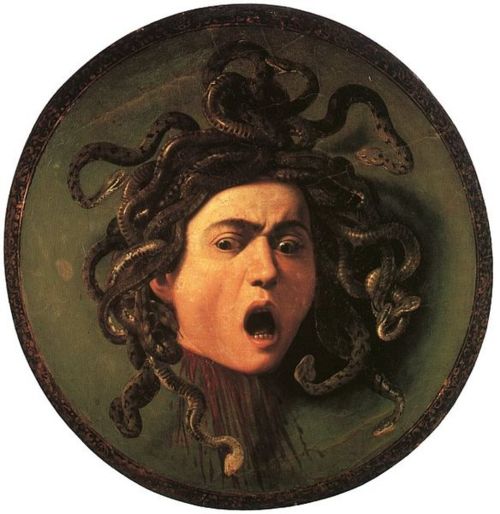Caravaggio’s Med: from the far east a conceptual solution to an old iconographic problem
- Michelangelo Merisi da Caravaggio, “Head of Medusa”, 1597 ca., Florence, Uffizi Gallery
- Michelangelo Merisi da Caravaggio, “Head of Medusa”, detail, 1597 ca., Florence, Uffizi Gallery
- Michelangelo Merisi da Caravaggio, “Head of Medusa”, detail, 1597 ca., Florence, Uffizi Gallery
The “Head of Medusa” by Michelangelo Merisi da Caravaggio (Uffizi Gallery, Florence) is an example of the parade shields frequently painted in the sixteenth century. Being a masterpiece by Caravaggio, the work has been examined by several scholars in recent decades. But, in spite of the efforts, no light has been shed yet on the true meaning of this particular interpretation of the Medusa’s head provided by the Lombard painter.
There are two details which have especially drawn academics’ attention: the shadow that the head is projecting on the green background and the blood that comes out from the neck. With regards to the first theme, there is indeed an inconsistency: the front of the shield is convex, but the shadow of the head, on the contrary, is painted as if it were on a concave surface. In other words, this shadow creates the illusion that the real surface is not convex but concave.
The second issue also embodies a rather exceptional case because this image, of the blood emerging from the neck, does not appear in any other representation of the same subject in the same period.
The explanations that some scholars have given to justify the shadow and blood were often the result of relations with other works that Caravaggio may have seen, or of the influence of literary sources, like those of Hesiod (Theogony, 274 – 284) and Ovid (Metamorphoses, IV, 769-803). Despite these hypotheses all being sufficient, they don’t seem anyway to be able to remove the doubts about the interpretation of the two incongruities. A convincing theory that has recently been suggested on the journal of visual art Predella is the one by the art historian Taro Kimura.
According to the scholar, the work of Caravaggio should be interpreted, in the context of “comparison”, as a shield on which the superiority of painting over sculpture tends to be visually emphasized. The issue of “comparison” between painting and sculpture was indeed a bone of contention for intellectuals in the sixteenth century Italy. By analyzing both Caravaggio’s painting and the parade steel shields on which the Head of the Medusa was carved, Kimura observes that on these latter ones the shadow can not be seen. He continues by asserting that to a very large extent, Caravaggio might have invented the shadow, which in this case is clearly recognisable, as an iconographic motif to demonstrate the superiority of his painting on the pad.
By referring to the “comparison of the arts,” Kimura also explains the other particular element, that of the blood emerging from the neck. Once again, by depicting something that couldn’t be made with sculpture, that is blood, or any other liquid for that matter, Caravaggio seems to highlight the dominance of painting over sculpture. Through a conceptual approach to art Kimura explains and indeed seems to solve this iconographic enigma.
July 18, 2015



